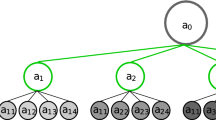Abstract
We address in this paper how to find clusters based on proximity and planar facets based on coplanarity from 3D line segments obtained from stereo. The proposed methods are efficient and have been tested with many real stereo data. These procedures are indispensable in many applications including scene interpretation, object modeling and object recognition. We show their application to 3D motion determination. We have developed an algorithm based on the hypothesize-and-verify paradigm to register two consecutive 3D frames and estimate their transformation/motion. By grouping 3D line segments in each frame into clusters and planes, we can reduce effectively the complexity of the hypothesis generation phase.
This work was supported in part by Esprit project P940.
Chapter PDF
Similar content being viewed by others
Keywords
These keywords were added by machine and not by the authors. This process is experimental and the keywords may be updated as the learning algorithm improves.
References
F. Lustman, Vision Stéréoscopique et Perception du Mouvement en Vision Artificielle. PhD thesis, University of Paris XI, Orsay, Paris, France, December 1987.
N. Ayache, Artificial Vision for Mobile Robots: Stereo Vision and Multisensory Perception. MIT Press, Cambridge, MA, 1991.
Z. Zhang, O. Faugeras, and N. Ayache, “Analysis of a sequence of stereo scenes containing multiple moving objects using rigidity constraints,” in Proc. Second Int'l Conf. Comput. Vision, (Tampa, FL), pp. 177–186, IEEE, December 1988.
Z. Zhang and O. D. Faugeras, “Estimation of displacements from two 3D frames obtained from stereo,” Research Report 1440, INRIA Sophia-Antipolis, 2004 route des Lucioles, F-06565 Valbonne cedex, France, June 1991.
D. Lowe, Perceptual Organization and Visual Recognition. Kluwer Academic, Boston, MA, 1985.
W. Grimson and T. Lozano-Perez, “Model-based recognition and localization from sparse range or tactile data,” Int'l J. Robotics Res., vol. 5, pp. 3–34, Fall 1984.
O. Faugeras and M. Hebert, “The representation, recognition, and locating of 3D shapes from range data,” Int'l J. Robotics Res., vol. 5, no. 3, pp. 27–52, 1986.
M. Thonnat, “Semantic interpretation of 3-D stereo data: Finding the main structures,” Int'l J. Pattern Recog. Artif. Intell., vol. 2, no. 3, pp. 509–525, 1988.
P. Grossmann, “Building planar surfaces from raw data,” Technical Report R4.1.2, ESPRIT Project P940, 1987.
P. Grossmann, “From 3D line segments to objects and spaces,” in Proc. IEEE Conf. Comput. Vision Pattern Recog., (San Diego, CA), pp. 216–221, 1989.
O. D. Faugeras, Three-Dimensional Computer Vision. MIT Press, Cambridge, MA, 1991. to appear.
P. Maybeck, Stochastic Models, Estimation and Control. Vol. 2, Academic, New York, 1982.
Z. Zhang, Motion Analysis from a Sequence of Stereo Frames and its Applications. PhD thesis, University of Paris XI, Orsay, Paris, France, 1990. in English.
Author information
Authors and Affiliations
Editor information
Rights and permissions
Copyright information
© 1992 Springer-Verlag Berlin Heidelberg
About this paper
Cite this paper
Zhang, Z., Faugeras, O.D. (1992). Finding clusters and planes from 3D line segments with application to 3D motion determination. In: Sandini, G. (eds) Computer Vision — ECCV'92. ECCV 1992. Lecture Notes in Computer Science, vol 588. Springer, Berlin, Heidelberg. https://doi.org/10.1007/3-540-55426-2_26
Download citation
DOI: https://doi.org/10.1007/3-540-55426-2_26
Published:
Publisher Name: Springer, Berlin, Heidelberg
Print ISBN: 978-3-540-55426-4
Online ISBN: 978-3-540-47069-4
eBook Packages: Springer Book Archive




